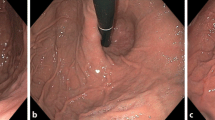Abstract
Background
The role of combined multichannel intraluminal impedance and pH monitoring (MII-pH) in diagnosing sliding hiatal hernia in gastroesophageal reflux disease (GERD) children remains unclear. We aimed to explore the clinical efficacy of MII-pH as a supplement diagnostic method for sliding hiatal hernia.
Methods
A total of 104 symptomatic GERD children [mean ± standard deviation (SD) age = 4.5 ± 5.5 years] were recruited. All of them were diagnosed as GERD with and without sliding hiatal hernia by barium and/or esophagogastroduodenoscopy study. All subjects received 24 h MII-pH monitoring to test the efficacy of this new modality.
Results
Sixteen children were diagnosed to have sliding hiatal hernia, and nine (56.3 %) of them received fundoplication. None of non-hiatal hernia children were indicated for fundoplication [risk difference (RD) 0.56; P < 0.001]. Impedance probes detected more reflux episodes than pH-probe in the whole study population (mean ± SD = 62.1 ± 47.8 vs. 47.8 ± 48.1 episodes; P = 0.02, paired t test). Due to the presence of pH-only reflux, the reflux episodes detected by impedance probes is less than that by pH probe in sliding hiatal hernia children (mean ± SD = 49.2 ± 78.9 vs. 103.7 ± 60.4 episodes; P = 0.01, paired t test). Ratio of reflux episodes detected by pH-probe to that by impedance probes >1 was more frequently noted in sliding hiatal hernia children than non-sliding hiatal hernia children (Odds ratio 58.33, P < 0.001). The sensitivity and specificity of this diagnostic tool to predict sliding hiatal hernia in GERD children are 93.8 and 79.6 %, respectively.
Conclusions
Ratio of reflux episodes detected by pH-probe to that by impedance probes >1 demonstrated by MII-pH study is a good screening test of sliding hiatal hernia in GERD children.


Similar content being viewed by others
Abbreviations
- EGD:
-
Esophagogastroduodenoscopy
- GERD:
-
Gastroesophageal reflux disease
- MII-pH:
-
Multichannel intraluminal impedance and pH monitoring
- UGI:
-
Upper gastrointestinal
References
Gorenstein A, Cohen AJ, Cordova Z, Witzling M, Krutman B, Serour F. Hiatal hernia in pediatric gastroesophageal reflux. J Pediatr Gastroenterol Nutr. 2001;33:554–7.
Jones MP, Sloan SS, Rabine JC, Ebert CC, Huang CF, Kahrilas PJ. Hiatal hernia size is the dominant determinant of esophagitis presence and severity in gastroesophageal reflux disease. Am J Gastroenterol. 2001;96:1711–7.
Avidan B, Sonnenberg A, Schnell TG, Chejfec G, Metz A, Sontag SJ. Hiatal hernia size, Barrett’s length, and severity of acid reflux are all risk factors for esophageal adenocarcinoma. Am J Gastroenterol. 2002;97:1930–6.
Wyman JB, Dent J, Holloway RH. Changes in oesophageal pH associated with gastro-oesophageal reflux. Are traditional criteria sensitive for detection of reflux? Scand J Gastroenterol. 1993;28:827–32.
Sifrim D, Castell D, Dent J, Kahrilas PJ. Gastro-oesophageal reflux monitoring: review and consensus report on detection and definitions of acid, non-acid, and gas reflux. Gut. 2004;53:1024–31.
Shay S, Richter J. Direct comparison of impedance, manometry, and pH Probe in detecting reflux before and after a meal. Dig Dis Sci. 2005;50:1584–90.
Antoniou SA, Koch OO, Antoniou GA, Asche KU, Kaindlstorfer A, Granderath FA, et al. Similar symptom patterns in gastroesophageal reflux patients with and without hiatal hernia. Dis Esophagus. 2012. doi:10.1111/j.1442-2050.2012.01368.x.
Weigt J, Malfertheiner P. Small volume acid relux in gastroesophageal reflux disease patients with hiatal hernia is only dectable by pH-metry but not by multichannel intraluminal impedance. Dis Esophagus. 2012. doi:10.1111/j.1442-2050.2012.01379.x.
Johnson LF, Demeester TR. Twenty-four-hour pH monitoring of the distal esophagus. A quantitative measure of gastroesophageal reflux. Am J Gastroenterol. 1974;62:325–32.
Kahrilas PJ, Quigley EM. Clinical esophageal pH recording: a technical review for practice guideline development. Gastroenterology. 1996;110:1982–96.
Vandenplas Y, Rudolph CD, Di Lorenzo C, Hassall E, Liptak G, Mazur L, et al. Pediatric gastroesophageal reflux clinical practice guidelines: joint recommendations of the North American Society for Pediatric Gastroenterology, Hepatology, and Nutrition (NASPGHAN) and the European Society for Pediatric Gastroenterology, Hepatology, and Nutrition (ESPGHAN). J Pediatr Gastroenterol Nutr. 2009;49:498–547.
Nelson SP, Chen EH, Syniar GM, Christoffel KK. One-year follow up of symptoms of gastroesophageal reflux during infancy. Pediatrics. 1998;102:e67.
Ashorn M, Ruuska T, Karikoski R, Laippala P. The natural course of gastroesophageal reflux disease in children. Scand J Gastroenterol. 2002;37:638–41.
Ruigómez A, Wallander MA, Lundborg P, Johansson S, Rodriguez LA. Gastroesophageal reflux disease in children and adolescents in primary care. Scand J Gastroenterol. 2010;45:139–46.
Fass J, Silny J, Braun J, Heindrichs U, Dreuw B, Schumpelick V, et al. Measuring esophageal motility with a new intraluminal impedance device. First clinical results in reflux patients. Scand J Gastroenterol. 1994;29:693–702.
Katzka DA, Paoletti V, Leite L, Castell DO. Prolonged ambulatory pH monitoring in patients with persistent gastroesophageal reflux disease symptoms: testing while on therapy identifies the need for more aggressive anti-reflux therapy. Am J Gastroenterol. 1996;91:2110–3.
Shaw GY. Application of ambulatory 24-hour multiprobe pH monitoring in the presence of extraesophageal manifestations of gastroesophageal reflux. Ann Otol Rhinol Laryngol Suppl. 2000;184:15–7.
Pilic D, Fröhlich T, Nöh F, Pappas A, Schmidt-Choudhury A, Köhler H, et al. Detection of gastroesophageal reflux in children using combined multichannel intraluminal impedance and pH measurement: data from the German Pediatric Impedance Group. J Pediatr. 2011;158:650–4.
Blonski W, Hila A, Vela MF, Castell DO. An analysis of distal esophageal impedance in individuals with and without esophageal motility abnormalities. J Clin Gastroenterol. 2008;42:776–81.
Ghezzi M, Silvestri M, Guida E, Pistorio A, Sacco O, Mattioli G, et al. Acid and weakly acid gastroesophageal refluxes and type of respiratory symptoms in children. Respir Med. 2011;105:972–8.
Acknowledgments
This work was supported by a grant from National Taiwan University Hospital (NTUH.100-M1671).
Conflict of interest
The authors have no potential, perceived, or real conflict of interest.
Author information
Authors and Affiliations
Corresponding author
Rights and permissions
About this article
Cite this article
Wu, JF., Hsu, WC., Tseng, PH. et al. Combined multichannel intraluminal impedance and pH monitoring assists the diagnosis of sliding hiatal hernia in children with gastroesophageal reflux disease. J Gastroenterol 48, 1242–1248 (2013). https://doi.org/10.1007/s00535-013-0750-0
Received:
Accepted:
Published:
Issue Date:
DOI: https://doi.org/10.1007/s00535-013-0750-0




